Square Foot Gardening Problems: 4 Years & I’m Out
Square Foot Gardening has pros & cons. I learned a lot from growing in square foot garden beds and had fun. After 3 years though, I had seen my share of Square Foot Gardening Problems. I decided to move on and try growing my vegetables in-ground.
What is a Square Foot Garden?
Square Foot Gardening is a revolutionary approach to gardening devised by Mel Bartholomew. To be successful with a Square Foot Garden you probably need to read his book, ALL NEW Square Foot Gardening. There are some subtleties that most people miss when they just take a quick look at a Square Foot Garden and decide that they “get the idea” and jump in without further research.
Some of the key points to this technique are:
- Growing in raised beds for various reasons including dense planting, avoiding compaction from walking on the garden, and making it a little easier to reach for planting, harvest and weeding.
- Growing in an artificial media instead of soil. This allows you to grow above poor soil or even on hard surfaces like concrete.
- Using a grid overlaid on the beds to separate interspersed crops and manage seed-sowing density which varies by crop.
There book outlines many more benefits, but I think I have highlighted the main aspects. Mel describes his background as an Engineer who retired and tried traditional row-planting of crops in a garden plot. He then relentlessly optimized and experimented to develop the Square Foot Garden method.
Why I Started a Square Foot Garden
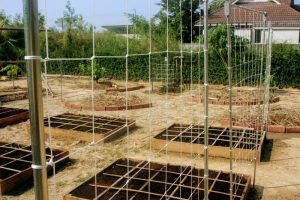
I grew up around vegetable gardens and in farming communities, but I had never done much gardening myself. After two decades of office-based workaholic engineering, I moved to Thailand. At the age of 39, and technically an unemployed immigrant, I found myself squinting in unfamiliar sunlight and wondering what to do with the plot of land we had bought next to our house.
I googled “how to grow vegetables” and other variants on that theme and stumbled across Square Foot Gardening. The confident reductionist engineering approach to gardening appealed to me. (wow, I am not the same person now)
The decision was more than just optimistically accepting a dogma. There were some real problems I was facing that a Square Foot Garden would address. The main one was that we had a plot of land with hard white compacted clay.
Mel’s Mix Adapted for Thailand: A Disclaimer
I need to be clear that I did not completely follow the Square Foot Garden method to the letter.
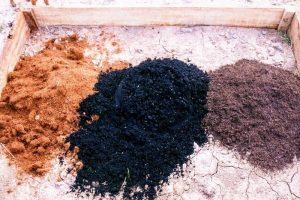
The Square Foot Garden method uses a soilless growing media based on Mel’s Mix of equal parts compost, peat moss and vermiculite. For countries where the last 2 ingredients are difficult to source, Mel recommends 100% compost.
I have only seen small hand-sized briquettes of sphagnum-based peat moss substitute at garden suppliers in Thailand for ridiculous prices. Likewise, vermiculite is hard to find and sold in small expensive quantities.
I decided against using 100% compost as I had nowhere near enough of my own on hand to fill all me beds. When I checked on buying the compost it was quite expensive and mostly a fine powder.
I made my own variation of Mel’s Mix with equal parts organic compost, biochar (carbonized rice hull), and coconut coir. The compost was a little expensive, but the other ingredients are low cost where I live.
The Benefits I Enjoyed with a Square Foot Garden
The first real benefit I realized from following the Square Foot Garden method was that, as a novice gardener, it made things simple. I just had to read the book and follow the advice laid out for me. As I mentioned, our clay was very hard and compacted so I was really happy to avoid digging.
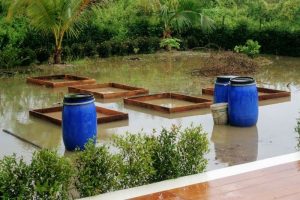
We can have quite heavy sustained rain during our wet season. In the first year there were quite a few floods, and I was pleased to have vegetables growing in raised beds above the water line.
I find it quite motivating to know each day what I had to do to keep my vegetables growing. When I had extra energy I could work on establishing fruit trees and other tasks in the garden, but most days I just needed to plant, water and harvest the raised beds. I got a bit geeky about it all with spreadsheets: tracking days to maturity and planning crops in advance.
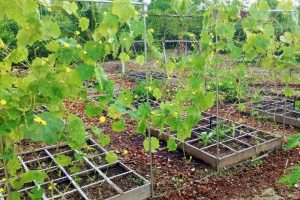
A second thing I had done that was a departure from Mel Bartholomew’s method was to dig up a few inches of clay before laying down the growing media on top. Over time as the media subsided and I grow crops with larger root systems, organic matter slowly worked its way down and started improving my soil.
I added three trellises made from rebar and electrical conduit. The Square Foot Garden book encourages vertical growing. This worked really well for me, especially with cucumber vines.
The Problems I had with a Square Foot Garden
Like many new converts to Square Foot Gardening, I was eager to show off my new raised beds. I was excited about the nutrient rich and friable growing media. I had some good results early on, especially after the coconut coir composted a bit.
High Water Consumption with a Square Foot Garden
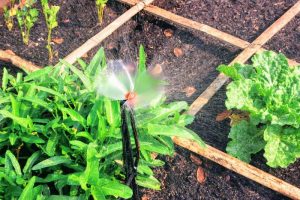
However, I was using a lot of water. In the 2nd year I planted some seed after the first rains, and went to Hong Kong for a few days with my wife. A family member had generously offered to water while we were away, but it was not enough and everything died off.
Adding automated sprinklers helped only a little. I still needed to hand-water twice a day in the hottest months. The growing media could absorb a lot of water but it also dried quickly. Raised beds made this even worse. I am sure there would have been less of a problem if the growing media was dug 6 inches into the ground instead.
Square Foot Garden Grids Can Be a Nuisance
I decided to get rid of the grid overlay after the initial fun had passed. I wanted to give the growing media a quick rake rather than hand-pulling weeds, and I often planted a single vegetable variety in a whole bed just for convenience. I had 8 beds, so this still gave me plenty of diversity across the garden.
Square Foot Garden Maintenance Problems
A problem that was looming for me was the untreated hardwood was buckling and rotting. I had consciously decided to not treat the wood as organic solutions were not readily available. As the time approached to rebuild the beds, I was starting to dread the work involved.
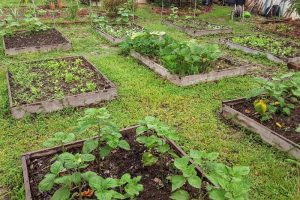
The other maintenance problem was that most of the nutrients in the original compost had long-since been consumed by crops or otherwise dissipated into the atmosphere or leached away by flooding. I was amending with my own compost and occasionally buying compost. Since I was not replacing the compost fast enough, 6 inches became 5 inches became 4 inches of growing media.
With the original coconut coir now composted to a fine dust, the growing media was quite compact now. I tried to fix the compaction and increase the volume by adding soil and river sand, but the results were not great.
Why I Stopped Square Foot Gardening
The problems I have described above were leading me to think about making a change. There are several things that brought it to a head.
I had been doing a lot of reading and viewing video on home gardening and micro-farming/market gardening. A lot of people who are really into square foot gardening buy expensive amendments like rock dust and seaweed. It struck me that this is an expensive way to mineralize a growing media when even poor soil has an adequate and diverse mineral content.
As I learned more about soil microbiology, I also started to wonder whether it was arrogance rather than wisdom to claim a sterile growing media was superior to soil which has sustained a teaming global ecology for millions of years. Again, the reductionist approach is to brew compost teas and compost wood to encourage fungal dominance.
At about the time I was reflecting on this, the side of one of my raised beds finally gave way and growing media flowed out through rotted hardwood. I took off the other side planks. It wasn’t a square foot garden bed any longer, but the plants were still growing . I pushed the growing media around over a larger area and grew a good crop of sweet corn.
After that I started to get excited about urban farming, exemplified by Curtis Stone, a.k.a. The Urban Farmer. There are quite a few people doing this sort of thing in North America, but Curtis started by grinding up the neglected lawns of his neighbors and growing on land he was leasing at low cost. This gave me the energy to pull my raised beds apart and form some in-ground beds instead.
Beyond Square Foot Gardening
I decided to form beds 30″ wide since this was what Curtis Stone was using, and is a pseudo-standard for some of the tools he and others use. With 10″ walkways, I worked out that I could actually end up with a lot more productive square feet and I had with the raised beds.
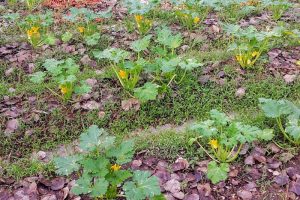
I took the opportunity to dig into the underlying clay and observed that it had changed color and was easier to work for a few inches below the surface.
I found this encouraging, and formed the beds. They were now a little bit raised, but also sat on loosened soil below the ground. The height of the beds gave me some minor flood mitigation.
In the first year, I covered the walkways with a 10″ synthetic wood product to both suppress weeds and give easier access to the garden in the wet season. Unfortunately, I used the cheaper 0.5 inch thick sheets which are designed for house siding. These thin boards cracked easily and made a mess.
Improved Walkways: Coconut Mulch
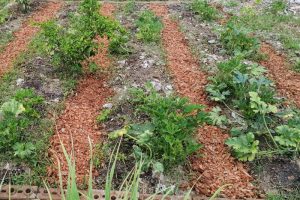
I removed the boards and instead laid down some coconut husks. With this I was able to raise the walkways to the same level as the growing beds. I think this helped with water retention in the summer months, as the coconut was now mulching the sides of the beds. When it was raining a lot, the coconut absorbed a lot of water too.
Every 6 months or so I top up the coconut husks. Just recently I decided to dig all the coconut out. I used the top layer which was reasonably composted as mulch elsewhere in the garden.
Deeper in the walkways was a lot of well-composted coconut coir and top-soil. I move all of this back onto the growing beds. Then I refilled the walkways with completely new coconut husks.
The clay is still quite hard when you dig down a few inches, but it is definitely improving. In some places I saw the clay still had cracks – but a lot of composted coconut had fallen into the cracks.
Square Foot Gardening was really good for me for the first few years, but it did have inherent problems. I have moved on to growing in-ground and will not be looking back.

